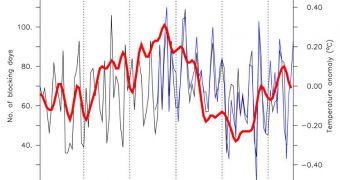A study led by experts at NASA determined that decades in which the North Atlantic Ocean is warmer than usual tend to lead to the creation of slow-moving winter weather systems. These atmospheric patterns are renowned for producing massive amounts of snowfall.
Such systems can also form when Atlantic temperatures are below average, but that only happens on extremely rare occasions. Conversely, it is very often that winters rich in precipitations affect countries in the Northern Hemisphere when temperatures increase.
NASA investigators now believe that an atmospheric phenomenon called atmospheric blocking (AB) is the most likely factor underlying this link. What is very interesting to note is that the phenomenon not only affects the atmosphere, but also the average temperature of the ocean underneath.
AB can be dangerous, to some extent, because they physical processes that create them can also lead to excessive rains, floods and droughts, as well as a large number of other extreme weather events.
Atmospheric blocking is largely caused by fast-flowing air currents traveling around the Earth in the upper part of the troposphere, called jet streams. When such a jet stream literally steals to much air mass from lesser wind patterns, they create instabilities and kinks in the air flow.
These irregularities usually last for several days, but can sometimes go on for weeks. However, their most severe consequence is the fact that they make whatever weather pattern is over a designated area stick over that region for prolonged periods of time.
Say New York City gets 5 days of rain, and then an atmospheric block develops above it before the rain clouds can dissipate. The metropolis would then continue to receive rain from the weather pattern above for any length of time between 5 days and a few weeks. It's easily understandable how this can lead to flooding.
The exact same process holds true for droughts, if a warm and dry weather patterns is blocked above an area. In general, most North Atlantic-caused AB events occur over Greenland and Western Europe. However, the effects of AB are not localized.
The last major blocking event that affected Greenland – in the winter of 2009-2010 – led to Snowmageddon, an instance of intense blizzards and snowstorm that severely battered the eastern seaboard of the United States.
In the new study, researchers also found that AB can weaken oceanic gyres, which are swirling currents that prevent warm, subtropical water from making its way far north, to where the ice sheets are.
“These warmer and more saline waters […] invade the subpolar ocean and cause a series of impacts. They erode the base of glaciers, contributing to the melting of the Greenland ice sheet. And the change in temperature and freshness of the waters can alter subpolar ecosystems, too,” Peter Rhines says.
The expert, an oceanographer at the University of Washington in Seattle (UWS), is a coauthor of the new investigation, details of which appear in the November 4 issue of the top journal Science.
The study team that carried out the new research was led by ocenographer Sirpa Häkkinen, who is based at the NASA Goddard Space Flight Center (GSFC), in Greenbelt, Maryland.

 14 DAY TRIAL //
14 DAY TRIAL //